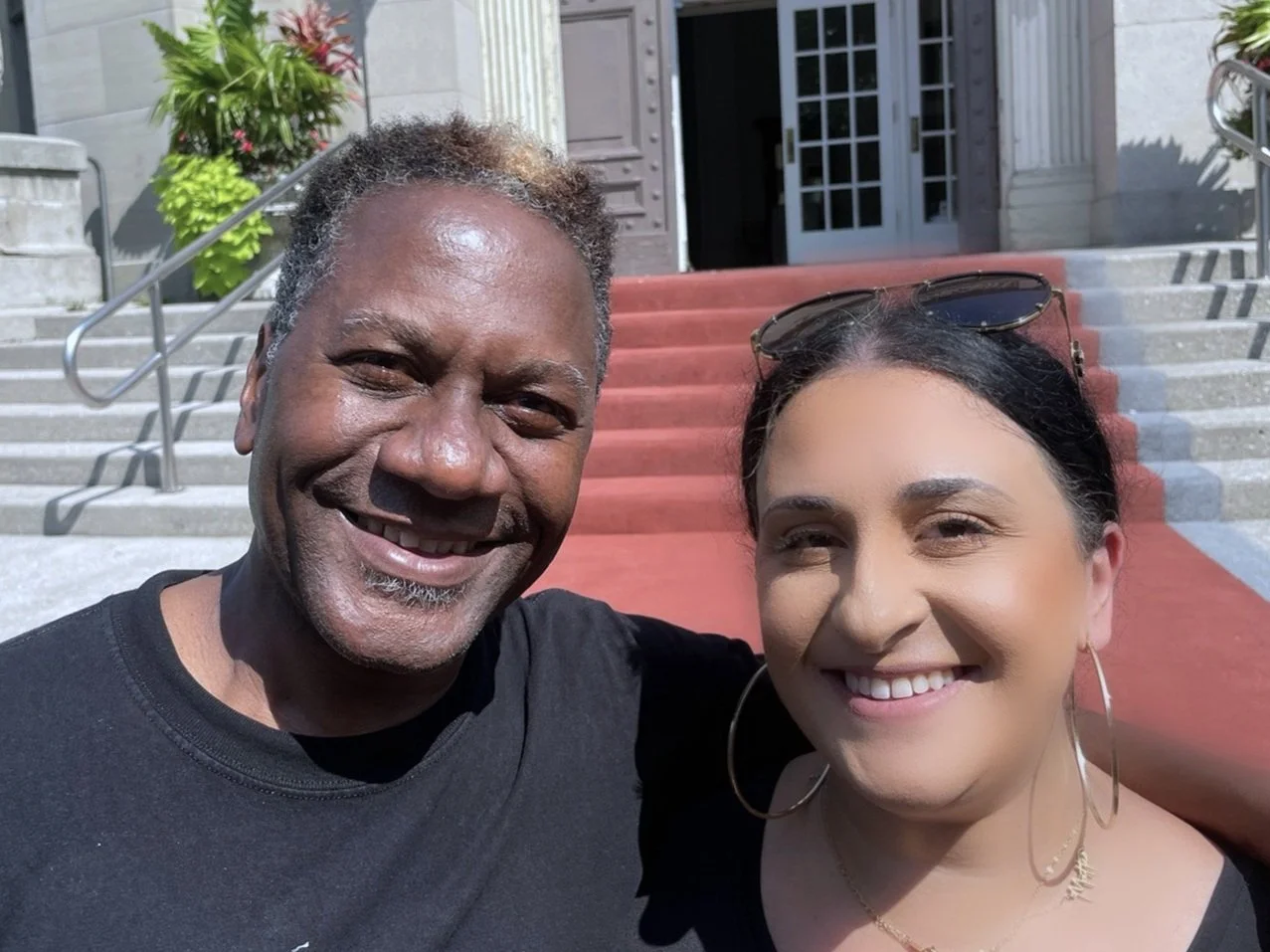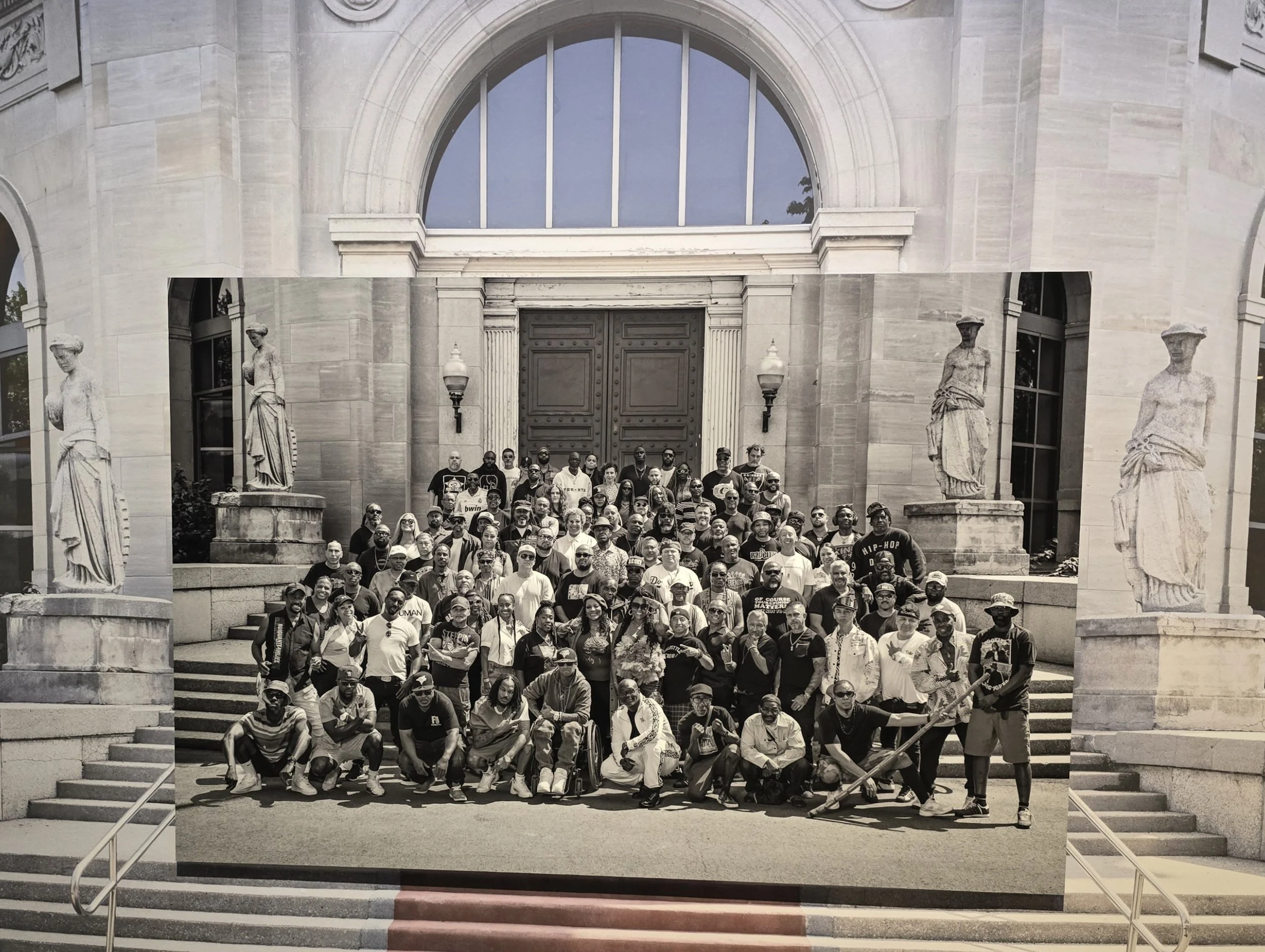The magic behind 'A Great Day in Toronto hip-hop' shoot
January 8, 2025
What are the chances of assembling a large group of people associated with Toronto’s hip-hop industry for a photo shoot in the middle of summer?
If anyone could pull off the feat, Patrick Nichols was the person.
For almost four decades, he has been photographing the city’s rap artists, many of whom he has a solid relationship with.
On the Liberty Grand Entertainment Complex’s western steps last August 14, Nichols –with assistance from hip-hop historian Dr. Francesca D’Amico-Cuthbert – brought together 103 MCs, DJs, break-dancers, graffiti artists, producers, promoters, designers and media personalities for the historic shoot titled ‘A Great Day in Toronto hip-hop’.
The historic photo shoot on the steps of the Liberty Grand Entertainment Complex (Photo by Patrick Nichols)
Anticipating doing a shoot sometime with most of the music genre’s personalities he photographed over the years, he did a test run in 2011 with his son at the same location.
“I was praying for an overcast day, but I didn’t get that last August,” Nichols said.
Choosing a location was easy.
“My studio was in Liberty Village from 1987 to 2018 until I sold it,” said Jamaican-born Nichols who came to Canada as a child and spent his adolescence in Toronto and Chicago before enrolling in Humber College’s photography program. “That is where I photographed every hip-hop artist.”
At first, he was leaning towards the Budweiser Amphitheatre where close friend and urban music concert promoter Jonathan Ramos staged one of his first shows.
“It is behind the Liberty Grand and has beautiful symmetrical lines,” noted Nichols who was mentored by American documentary, commercial and fine art photographer Dave Jardano. “The original plan was to shoot there, but that would be one line. That would have meant I had to get a cherry picker and then get everyone up on stage. I also could not figure out if the people behind the scenes should be on stage and the performers in the audience.”
While thinking about what to do, Art Gallery of Ontario (AGO) Assistant Curator, Photography, Dr. Julie Crooks asked Nichols to recreate ‘A Great Day in Hip Hop’ that is a black and white photograph of over 200 hip-hop artists and producers in Harlem captured by late photographer Gordon Parks for XXL magazine in 1998.
Rapper and producer Kardinal Offishall was the first person Nichols contacted about the shoot.
Maestro, Saukrates and Solitair were also among the first group of artists he spoke with about the project. He also reached out to Director X and Drake’s management.
Kardinal and Maestro – the first rapper to win a Governor-General’s Performing Arts Award -- were unable to make the shoot because of prior work commitments while Director X was a last-minute cancellation.
“People should not focus on the people who are missing,” said D’Amico-Cuthbert who Nichols enlisted last June to work on the project. “It is about the day that the photographer captured, the moment, the energy and the eras. A few of the younger artists might not have heard of Bobby ‘Spinner’ Martin who is one of the original b-boys in the mid-to-late 1970s. This was two eras of Toronto hip-hop meeting for the first time on the steps of this building. That is the power of the photo.”
In 2021, RapCity producer Michele Geister introduced them to one another.
“We met online and started talking about Patrick’s extensive archival photo collection,” D’Amico-Cuthbert said. “I knew of his work from album cover artwork in addition to Toronto hip-hop photo exhibits. For Patrick’s shoot, I did a lot of stuff beforehand, on the day of the shoot and after. I wrote the photo description and helped identify some of the people in it.”
The Hip-Hop Education Centre Chief Research Officer is convinced Nichols' iconic image will withstand the test of time in the same way that ‘A Great Day in Harlem’ does.
“There are two photos of the Toronto hip-hop scene that precede this one,” pointed out D’Amico-Cuthbert whose postdoctoral research explores Toronto rap music’s relationship to commerce, anti-Black market segmentation and the availability of state revenue streams and marketplace exposure. “One was taken in the early 1990s by Rick McGinnis and it was with a small group of folks, many of whom were with Beat Factory. The second one was taken in 2010 by Che Khotari. What sets Patrick’s photo apart is the sheer numbers and the diversity. He captured how ethno-racially diverse the Toronto hip-hop scene has been since its inception.
“In representing all the eras, he takes the Toronto hip-hop timeline back to 1976 which no one has ever done and very few people have written about. The photo shows a deep presence of women in the city’s hip-hop and it represents all nine elements of the culture. He also did an excellent job of highlighting those that people never heard of. There is an infinite amount of knowing and learning to be done and I think this photo does a great job of introducing people to new names and new eras. It is a starting point, even for those who are in the culture.”
Having the right tools for the production was essential for Nichols who is a close friend of Ivan Berry who managed many of Toronto’s top hip-hop artists.
“I used a Phase One digital camera which is like 150 megapixels,” he said. “It is almost like a large format. If I were to shoot it in film, it would be like a 4x5 camera where you get a great deal of detail. But now you have 150 megapixels whereas a normal DSLR (digital single-lens reflex) might be about 30 to 40 megapixels. This is like a medium format where you can zoom right in and see the hairs on the eyelashes in that photograph. I also used a normal lens which would probably be about 75 or 80 millimeters. I might have gone a little wider, but I did not want to get a distortion. I brought lights as well for a little bit of fill light so it is almost like studio lights outside. It started to get a little bright towards the end. If I were to do it all over again, I would do it an hour earlier.”
The shoot took place just after midday.
“I started around 11.30 a.m., but a few people were late,” said Nichols who was the official photographer for The Dream Warriors 1991 European tour. “We ended up doing it around 12.15 p.m. at which point the light started to come across the top of the building. I didn’t give myself enough time for that. I assumed I would be done by noon if everyone was there by 11.30. It did not work out that way. Also, people wanted to hang out and chat. We took a break for people to talk and take photos.”
For multi-award-winning DJ, Host & Event Specialist Mel Boogie, it was a balancing act handling work and the shoot.
“I could not get time off from my job and I was not going to miss being part of this photograph,” the Polaris Music Prize Juror pointed out. “While I was waiting for them to get everyone together, I was in my car working. It is essential we document our hip-hop history and I was honoured to be part of this shoot. We tend to look at New York City as where it all started and forget that we have our own founding mothers and fathers of the culture in Canada. It was awesome to be part of the day in hip-hop, highlighting Toronto’s pioneers and recognizing our chapter in this history book.”
Winston ‘Styles’ Searles of the pioneering ‘Intrikit’ breakdancing crew was honoured to be a participant.
“We are proud to have contributed to the global scene and I am pleased that this aspect of Canadian history is now being documented for posterity,” he added.
Juno-award-winning rapper Tona was also thrilled to be invited.
“It was an excellent day to build comradery with those involved,” noted the artist who won a Juno in 2015 for ‘Best Rap Recording’. “Hip-hop stories in this city need to be told and documented from many perspectives so it stays refreshed.”
Jeff ‘Spade’ Duke, the brother of film director/producer/writer Alison Duke who is in the photo, felt he was among royalty.
“To have the people who directly inspired me or helped me to be the type of artist I am as well as my peers who I shared the spotlight with in one place was amazing,” noted the b-boy dancer, graffiti writer, emcee and independent record label owner.
The participants in the historic photo shoot (Image contributed)
‘A Great Day in Toronto Hip-Hop’ is included in ‘The Culture: Hip-Hop and Contemporary Art in the 21st Century’ exhibit that is grounded in the origin of the music genre in the United States, with a focus on art and music for the last two decades.
Some elements of Canada’s hip-hop culture are part of the exhibition that runs until April 6 at the Art Gallery of Ontario.
“For the AGO to create a space for local Black art is huge,” said Nichols who, in 2016, presented his first solo exhibition, ‘Kushe’, at the Black Artists’ Network in Dialogue (BAND) gallery. “It is an important step and new beginning. It leaves room for those that come later that may expand on that and do amazing things. I am looking forward to what comes next.”
D’Amico-Cuthbert also acknowledged the AGO for embracing the art form.
“For a long time, Canadian culture has not been open to hip-hop culture and the way that local people in Toronto have intervened and transformed not just culture at large, but the city,” she said. “Toronto hip-hop is responsible for the city being renamed T-Dot and The Six. So much of how this city brands itself is because of hip-hop and yet, for the longest time, institutions have had their doors closed. What the AGO has done, which sets itself apart, is that it has changed the course we tell the story of hip-hop. What Patrick’s photo does and so many of the works that are locally based do is say hip-hop culture is and has always been about community. It is not only or uniformly about celebrity and the mainstream. To widen the frame is very important.”








